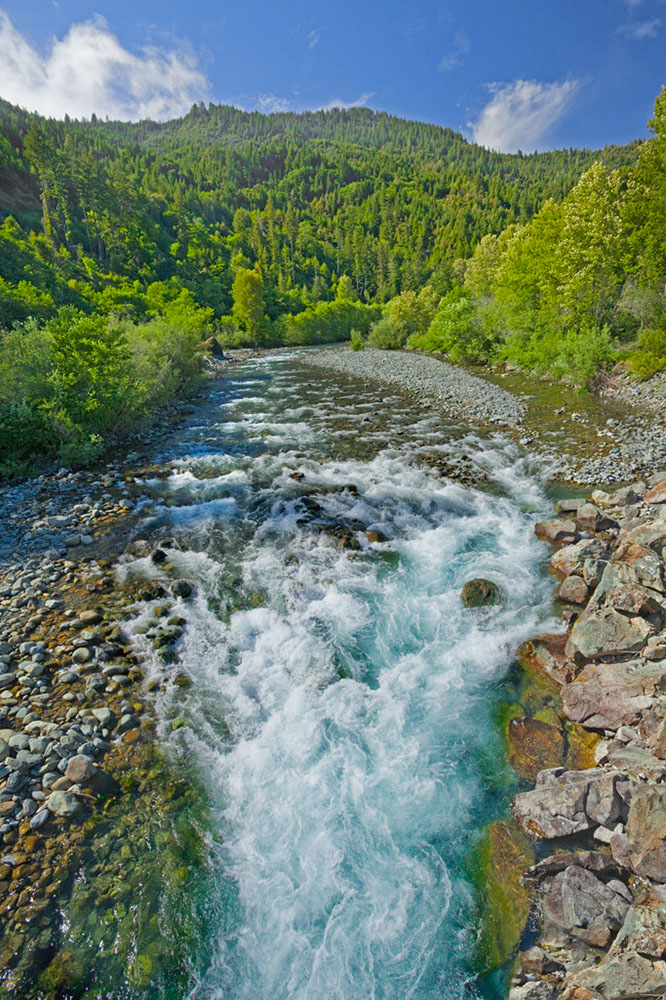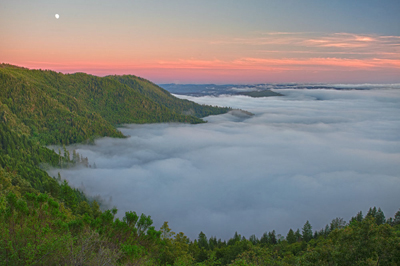Yurok Stewardship of Klamath’s Blue Creek Bodes Well for Fish

Last summer I had the privilege of camping overnight with members of the Yurok Tribe and Western Rivers Conservancy on Blue Creek, one of California’s loveliest streams and an important cold-water refuge for migrating salmon and steelhead. The creek tumbles down the misty Siskiyou Mountains not far from Redwood National Park. I hiked its banks and snorkeled its pools for a close look at young coho and Chinook salmon. At dusk we sat at the stream’s edge eating fresh salmon smoked Yurok style, on redwood stakes circling an open alder wood fire. Our campsite was once a Yurok village.
The gathering called for tradition: we were celebrating the impending return of both the village site and the entire lower Blue Creek watershed to the Yurok people.
|
The cold, clear waters of Blue Creek are prime |
The Yurok, in partnership with Western Rivers Conservancy, is well on its way toward acquiring from Green Diamond Resource Co. the 47,000 acres along the creek to create a “salmon sanctuary.”
Full disclosure: I am on WRC’s board of directors. I joined mostly because of the Blue Creek project. It feels good to work on something positive for fish conservation, having spent so much of my career documenting the decline of California’s native fishes.
Beyond that, the Blue Creek acquisition is an extraordinary conservation arrangement in at least three ways:
- Buying an entire watershed for conservation purposes is rare, though it is essential for persistence of healthy stream ecosystems
- Blue Creek is choice habitat for salmonids because its stays cold and clear year-round.
- The Yurok Tribe has agreed to partially waive its sovereign immunity so that key federal and state environmental restrictions benefiting fish and wildlife will apply in perpetuity.
There’s a lot about Lower Blue Creek worth protecting. It’s the largest tributary on the lower 40 miles of the Klamath River and its watershed drains 127 square miles of coastal rainforest, where rainfall averages about 100 inches a year.
The upper watershed is already protected; it starts in Siskiyou Wilderness at about 4,800 feet above sea level. Blue Creek maintains its salmon-friendly chill and clarity because it is so steep and so often fogged in. The creek will be somewhat buffered from global warming, assuming the fog continues.
The stream’s flows are typically 40 to 50 cubic feet per second (cfs) in early fall and rise as high as 48,000 cfs during big storms. Because of the relatively high flows, there is usually a large pool just below its mouth in the Klamath River. This serves as a cool-water refuge for salmon migrating upstream in early fall, when river temperatures are often stressful.
Blue Creek supports runs of coho salmon, winter steelhead (rainbow trout), coastal cutthroat trout, fall Chinook salmon – and a somewhat anomalous, if not unique late-fall run of Chinook. Other native residents include speckled dace, smallscale sucker, prickly sculpin, Coastrange sculpin and Pacific lamprey.
The watershed is also a good place for all other kinds of animals and plants being within the Klamath-Siskiyou Bioregion, where endemism is high. It is home to threatened species such as the northern spotted owl, Humboldt marten and marbled murrelet, a small seabird from the North Pacific. It is easy to think of the long-gone California condor and timber wolf eventually returning to a revived landscape here.
|
Fog rolling in from the Pacific Ocean helps maintain |
But Blue Creek is far from pristine. Much of the watershed has been logged at one time or another, so the forest is predominately second- and third-growth redwood, fir and cedar. Logging roads lace the lower watershed.
The creek has cut down below its natural channel height in places, the result of past logging, road construction and grazing. Feral cattle graze the meadows and stream banks. Wild coho and Chinook are in decline largely because of these factors and production of hatchery fish, which stray and interbreed with wild fish.
The good news is that the Yurok Tribe is committed to managing the land and water sustainably, recognizing the positive benefits this will have for them. For example, the tribal salmon fishery in the lower Klamath River will be more sustainable if wild, rather than hatchery-produced, salmon remain a significant part of the catch.
If all goes as planned, 72 square miles of former tribal land will be owned and managed by the tribe for “forest health, clean water, fish habitat, and cultural rejuvenation,” according to WRC. This includes land the organization already acquired from the timber company and designated Yurok Tribal Community Forest.
Funds have come from both public and private sources, including large grants and loans from the David & Lucille Packard Foundation and an anonymous foundation.
Much of the funding for the final phase of the acquisition is truly innovative. It involves federal New Markets Tax Credits, originally designed to help blighted urban areas to recover, and selling credits for carbon sequestration in rejuvenated forests.
The Blue Creek Salmon Sanctuary is still a work in progress – more funding is needed – but it is already a model of watershed-scale conservation that can benefit fish and people.
Key elements are a well-designed acquisition, a tenacious and innovative conservation group, and a dedicated long-term steward, the Yurok Tribe, with a vested economic, ecological, cultural and even spiritual interest in protecting the resources.
The combination may seem unusual, but I can imagine other large-scale projects being modeled on its success, including ones that have other Native American groups reclaiming some of their heritage. I hope to visit such projects in the future.
Peter Moyle serves on WRC's Board of Directors


